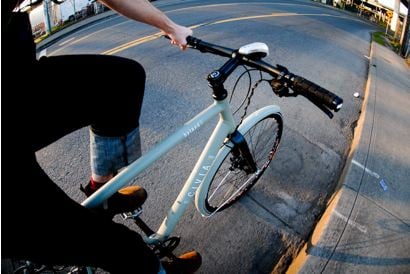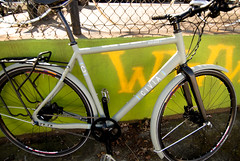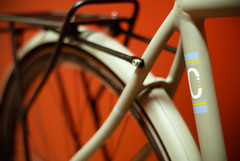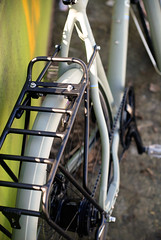
(Photos © J. Maus)
The latest addition to my test-bike stable is the new Hyland from Civia Cycles.
Civia is the just-launched, high-end commuter bike brand created by Quality Bicycle Products. “QBP”, as they’re known in the industry, is a Minneapolis-based bike parts and accessories distributor/juggernaut that serves over 5,000 bike shops and also owns venerable brands like Surly and Salsa.
I got my first look at this bike back in September when photos and specs hit the web after its debut at Interbike (a massive bike industry trade show held each year in Las Vegas). Civia raised my eyebrows for several reasons.
“Our audacious goal: Every family, every week, enjoying bicycles as transportation.”
–from the Civia website
First, with QBP, the brand had a solid pedigree and (I would assume) stable financial backing, a prerequisite for any bike industry endeavor. I’m not as close to the industry as I used to be, but I remember enough to know that QBP is a reputable and respected company that knows how to develop a successful bike brand. Second, I liked that they were boldy going after a high-end commuter market (that might not even exist yet) and they were doing it with a bike that at first glance seemed to be distinctive, sporty, functional and stylish enough to really catch on.
And finally, I appreciated that yet another major company was jumping head-first into designing and marketing bikes for transportation. It’s one of many recent signs that the bike industry is finally waking up to the American biking renaissance.
Or, as Civia puts it; “Our vision is to lead bicycling into its greatest era.”
So, when Civia brand manager Scott Thayer called and asked if I’d like to see one, I jumped at the chance. Unfortunately I’ve only got a few days to form an impression of the bike, but thanks to help from Mark over at Revolver bike shop, I’ve already got it built up and on the streets.
Civia offers the bike as a frameset only, or with a full Shimano Alfine component group ($1,985), a traditional derailleur build ($1,985 with XT components), or a Rohloff build ($3,150) that utilizes arguably the best internal hub/shifter on the market. Scott sent me the Alfine version.
With just a few rides under my belt, a few things jump to mind. Compared to other bikes I’ve tested (Batavus Old Dutch and Socorro, Electra Amsterdam, Bike Friday Tikit) this one is clearly focused more on performance and speed. It’s got a saddle you’d see on a racing bike, a straight-blade carbon fork, and handlebars with just a slight bend.
With several race-worthy parts from the likes of Salsa and Thompson, the bike comes in at well-under 30 lbs.
But as much of a speedster it’s made out to be, it’s also got some commuter-worthy highlights. These include a hub-generator front headlight, disc-brakes, full-wrap fenders, and a solid pannier rack.
Glaringly absent from my point of view is a bell, a rear light, a kickstand and a chainguard (update: chainguards will be standard with complete bikes): To me, a city bike feels naked without these essentials.
So how does it ride? I’m still forming my thoughts but my initial impression is that the bike is smooth, yet decidedly stiff, especially compared to the other bike I’ve been riding. I thought I wanted my perfect city bike to be sleek and fast, but now that I’ve got one that is, I’ve realized I’m looking for the better balance of comfort, speed, and predictable handling (especially with our roads in such disrepair).
Other thoughts about the ride experience so far: the Alfine components are elegant to the eye and smooth to the touch, and the metal fenders, although I appreciate them being color-coordinated, leave something to be desired. I’m a bit Type-A about noises, clicks and things being perfectly aligned on my bike, and these metal fenders seem excessively floppy easily bent.
Will the Hyland be the bike that lures would-be commuters to leave their Lexus at home? I’d like to think a snazzy, sleek, and functional bike could help make that happen. But the biggest hurdle for Civia, and others in the industry who hope to capitalize on commuting conscious consumers, will be convincing more Americans to get on a bike in the first place.
If the industry’s growing interest in the commuter market was coupled with similar efforts in the advocacy realm, than “bicycling’s greatest era” might actually be much more than a marketing slogan.
For more on the Civia Hyland, visit CiviaCycles.com or browse the comment threads at CommuteByBike.com here and here.
For more photos, browse the Civia Hyland photo gallery.







